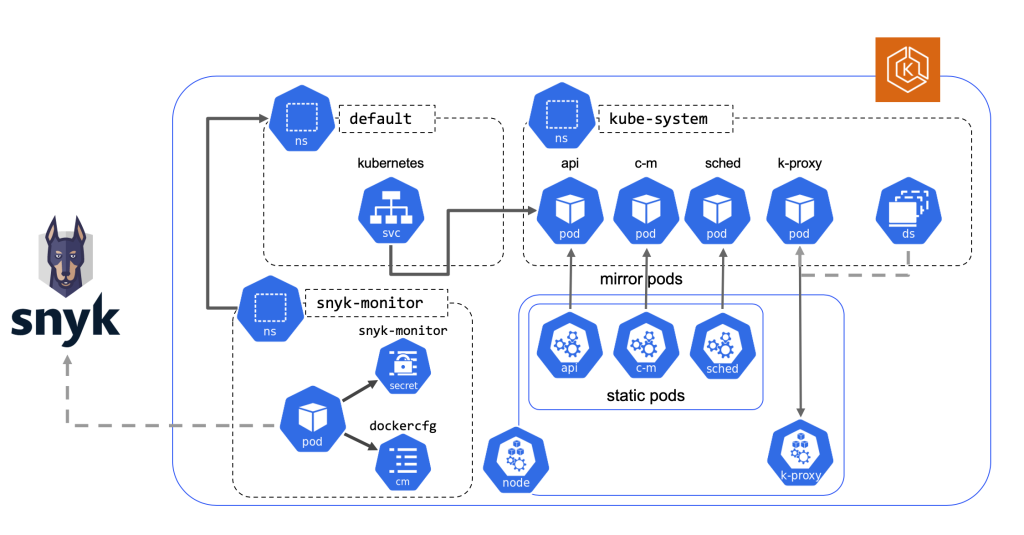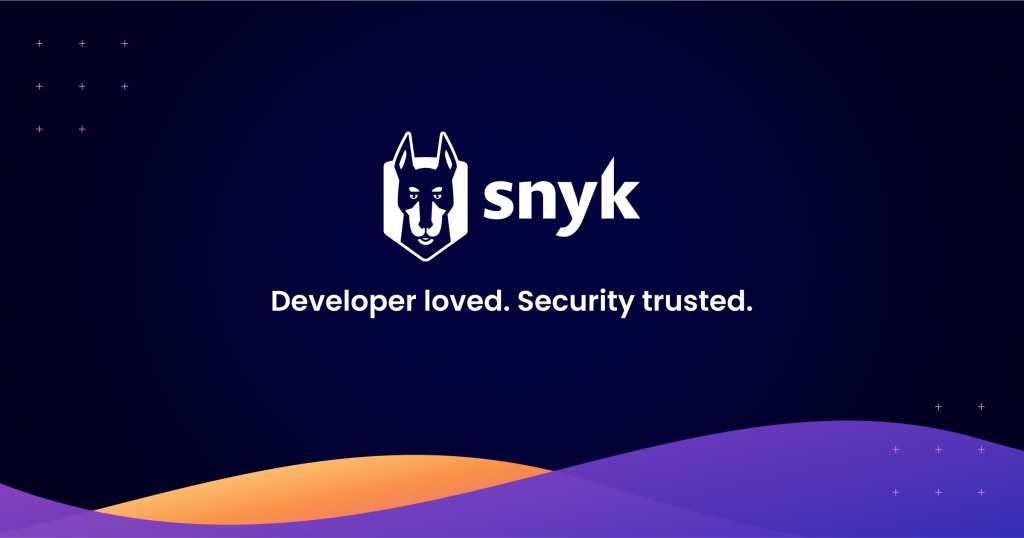What is Snyk?

Snyk is a developer security platform that helps organizations find and fix vulnerabilities across their entire software development lifecycle, from code to containers and infrastructure. It’s like a security superhero for developers, providing protection at every stage of the software creation process.
Here’s a breakdown of its key features:
- Vulnerability Scanning: Scans code, open-source dependencies, container images, and infrastructure as code for known vulnerabilities.
- Priority and Remediation: Provides actionable insights to prioritize and fix vulnerabilities effectively.
- Automation and Integration: Integrates seamlessly with developer workflows, CI/CD pipelines, and IDEs for continuous security.
- Compliance and Reporting: Helps meet compliance requirements and generate comprehensive security reports.
Top 10 use cases of Snyk?
Now, let’s unlock the potential of Snyk with the top 10 use cases:
1. Secure Agile Development: Snyk integrates seamlessly with popular Agile tools and CI/CD pipelines, enabling continuous security checks throughout the development process.
2. Open-Source Dependency Management: Identifies and mitigates vulnerabilities within open-source libraries and packages used in projects.
3. Container Security: Scans container images for vulnerabilities and misconfigurations, ensuring secure deployments.
4. Cloud Infrastructure Security: Secures cloud infrastructure configurations and identifies potential security risks.
5. API Security: Protects APIs from common attacks and ensures secure data handling.
6. Compliance Management: Helps organizations meet various security compliance requirements like GDPR and SOC 2.
7. Developer Empowerment: Equips developers with security knowledge and tools to proactively build secure software.
8. DevSecOps Collaboration: Bridges the gap between security and development teams, facilitating seamless collaboration.
9. Cost Reduction: Proactive vulnerability detection prevents costly security breaches and data leaks.
10. Improved Brand Reputation: Demonstrates a commitment to security, building trust with customers and stakeholders.
Snyk provides a holistic approach to developer security, empowering organizations to build secure software from the ground up. By using Snyk, organizations can:
- Reduce security risks: Proactively identify and fix vulnerabilities before they can be exploited.
- Improve software quality: Build secure and reliable software that customers can trust.
- Boost developer productivity: Integrate security seamlessly into developer workflows without slowing them down.
- Meet compliance requirements: Demonstrate compliance with industry standards and regulations.
If you’re looking for ways to enhance your organization’s software security, Snyk is a powerful tool that can help you achieve your goals.
What are the feature of Snyk?
Snyk’s effectiveness in securing your software stems from a well-defined architecture and efficient workflow. Let’s dive into the details:
1. Architecture:
- Cloud-based platform: Snyk operates as a cloud-based service, meaning your data and analysis are hosted securely in their infrastructure. This ensures scalability and accessibility for users anywhere.
- Distributed scanning engines: Snyk utilizes a network of distributed scanning engines to analyze code, dependencies, containers, and infrastructure as code. This parallel processing ensures fast and efficient vulnerability detection.
- Vulnerability database: Snyk maintains a constantly updated database of known vulnerabilities, encompassing various sources like MITRE ATT&CK, NIST National Vulnerability Database, and Open Source Security Foundation.
- API-driven communication: The platform relies on APIs to integrate seamlessly with developer workflows, CI/CD pipelines, and issue trackers. This enables smooth data exchange and automated security checks.
2. Workflow:
- Integration: Snyk integrates with your existing development process through plugins, SDKs, and API connections. This ensures security checks become part of your familiar workflow.
- Scanning: Based on your configuration, Snyk scans your code, dependencies, containers, or IaC templates for vulnerabilities.
- Analysis and Prioritization: The platform analyzes the identified vulnerabilities, considering severity, exploitability, and potential impact. This helps prioritize which vulnerabilities require immediate attention.
- Remediation: Snyk provides actionable insights and recommendations for fixing vulnerabilities. These include suggestions for patches, dependency upgrades, and configuration changes.
- Reporting and Monitoring: The platform generates comprehensive reports on identified vulnerabilities, remediation progress, and overall security posture. This data allows you to track progress and monitor your security posture.
3. Key Aspects:
- Automation: Snyk focuses on automating vulnerability scanning and reporting wherever possible. This frees up developers’ time and ensures continuous security checks throughout the development lifecycle.
- Collaboration: Snyk facilitates collaboration between development and security teams by providing shared visibility into vulnerabilities and progress. This fosters a culture of DevSecOps where security is everyone’s responsibility.
- Customization: Snyk offers customizable policies and scanning configurations to adapt to your specific needs and project requirements.
- Continuous Improvement: The platform constantly evolves with new features and updated vulnerability databases. This ensures your security protection stays ahead of emerging threats.
By understanding Snyk’s architecture and workflow, you can appreciate how it seamlessly integrates with your development process and empowers you to build secure software.
How Snyk works and Architecture?

To offer a truly comprehensive understanding of Snyk’s internal workings, let’s delve deeper into its architecture and workflow:
1. Architectural Layers:
- Frontend: Provides user interface for interacting with scan results, reports, and configurations.
- API Gateway: Manages API interactions and routes requests to appropriate backend services.
- Scanning Layer: Utilizes diverse engines for different scan types (SAST, SCA, DAST, IaC)
- Code Analyzers: Analyze source code for vulnerabilities using static analysis techniques.
- Dependency Scanners: Identify vulnerabilities within open-source and proprietary dependencies.
- Container Scanners: Analyze container images for vulnerabilities and misconfigurations.
- IaC Scanners: Evaluate infrastructure as code templates for security weaknesses.
- Vulnerability Database: Houses a continually updated database of known vulnerabilities from various sources.
- Analysis and Prioritization Engine: Analyzes vulnerabilities based on severity, exploitability, potential impact, and context.
- Recommendations Engine: Suggests appropriate remediation actions for discovered vulnerabilities.
- Reporting and Monitoring System: Generates comprehensive reports and visualizes security posture for monitoring and tracking progress.
2. Detailed Workflow:
- Integration: Snyk integrates with your development environment through plugins, SDKs, or APIs.
- Triggering Scans: Scans can be triggered manually, automatically upon code changes, or integrated into CI/CD pipelines.
- Scanning and Analysis: The relevant engine(s) based on scan type (code, dependencies, container, IaC) analyze the target resources.
- Vulnerability Detection: Snyk identifies vulnerabilities by cross-referencing scan results with its extensive vulnerability database.
- Prioritization and Analysis: Vulnerabilities are prioritized based on factors like severity, exploitability, and potential impact. Contextual information like affected files and lines of code is extracted.
- Remediation Recommendations: The platform suggests feasible remediation options like patches, dependency upgrades, and configuration changes.
- Reporting and Monitoring: Comprehensive reports detailing identified vulnerabilities, suggested actions, and overall security posture are generated. Security metrics are visualized for continuous monitoring.
3. Additional Notes:
- Snyk leverages machine learning and artificial intelligence to enhance vulnerability detection and prioritize findings effectively.
- The platform offers multiple security testing options like fuzzing and penetration testing for specific needs.
- Snyk prioritizes privacy and security, ensuring your data is encrypted at rest and in transit.
By understanding the intricate workings of Snyk’s architecture and workflow, you gain a deeper appreciation for its capability to scan, analyze, prioritize, and guide remediation for vulnerabilities across your entire software development lifecycle.
How to Install Snyk it?
There are two main ways to install Snyk: using a package manager or downloading a binary. Let me guide you through both options:
Using a package manager:
- Choose your package manager: Snyk supports npm (Node.js) and Yarn.
- Install Snyk:
- npm: Open a terminal and run
npm install snyk -g. - Yarn: Open a terminal and run
yarn global add snyk.
- npm: Open a terminal and run
Downloading a binary:
- Head to the Snyk CLI download page.
- Choose your operating system: Download the appropriate binary for your system (e.g., macOS, Linux, Windows).
- Make the binary executable:
- macOS: Open a terminal and run
chmod +x snyk-macos. Then, move the file to yourPATHdirectory like/usr/local/bin(you may need administrator privileges). - Linux: Open a terminal and run
chmod +x snyk-linux. Then, move the file to yourPATHdirectory like/usr/local/bin. - Windows: Download the
snyk-win.exefile and move it to a directory in yourPATHenvironment variable.
- macOS: Open a terminal and run
Important Tips:
- Authenticate Snyk: After installation, run
snyk authin your terminal to authenticate with your Snyk account. - Verify the installation: Run
snyk -vto check the installed version of Snyk.
No matter which method you choose, remember that you need Node.js installed on your system for Snyk to work properly.
Basic Tutorials of Snyk: Getting Started

Snyk helps developers and security professionals find and fix vulnerabilities in their code, open-source dependencies, containers, and infrastructure. Here’s a breakdown of basic Snyk tutorials to get you started:
1. Introduction to Snyk:
- What is Snyk?
- A developer-first security platform that automates vulnerability scanning and remediation across the software development lifecycle (SDLC).
- Identifies vulnerabilities in code, dependencies, containers, and infrastructure.
- Provides actionable insights and guidance to fix vulnerabilities.
- Benefits of using Snyk:
- Proactive vulnerability detection and prevention.
- Improves code quality and security posture.
- Reduces time spent on manual security tasks.
- Integrates seamlessly with CI/CD pipelines.
2. Getting Started with Snyk:
- Create a free Snyk account:
- Visit Snyk official website and click “Sign Up.”
- Enter your email address and create a password.
- Verify your email address and fullfil your profile.
- Install the Snyk CLI:
- The Snyk CLI is a command-line tool for scanning code and dependencies.
- Choose your operating system from the Snyk official website.
- Use the installation instructions based on your OS.
- Authenticate with Snyk:
- Run
snyk authin your terminal. - Follow the prompts to copy and paste your API token from the Snyk web UI.
- Run
3. Scan your Code:
- Navigate to your project directory in the terminal.
- Run
snyk testto scan your code for vulnerabilities. - Snyk will display a list of vulnerabilities found, along with their severity and CVEs.
4. Fixing Vulnerabilities:
- Snyk provides guidance on how to fix each vulnerability.
- You can update vulnerable dependencies, patch your code, or ignore the vulnerability if it’s not relevant.
- Monitor your project over time to ensure vulnerabilities are fixed and new ones don’t arise.
Bonus Tip:
- Explore Snyk’s integrations with popular CI/CD tools and IDEs for automated vulnerability scanning throughout your development workflow.
These are just the basic steps to get started with Snyk. There are many more features and functionalities to explore as you become more familiar with the platform. Feel free to dive deeper into the resources provided above for a comprehensive understanding and to tailor Snyk to your specific needs.
- Mutual of Omaha: Selection and Interview process, Questions/Answers - April 15, 2024
- AES: Selection and Interview process, Questions/Answers - April 15, 2024
- Amphenol: Selection and Interview process, Questions/Answers - April 15, 2024

